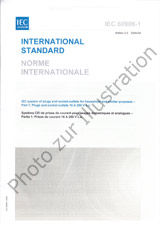Wir benötigen Ihre Einwilligung zur Verwendung der einzelnen Daten, damit Sie unter anderem Informationen zu Ihren Interessen einsehen können. Klicken Sie auf "OK", um Ihre Zustimmung zu erteilen.

IEC 61008-2-1-ed.2.0
Residual current operated circuit-breakers without integral overcurrent protection for household and similar uses (RCCBs) - Part 2-1: RCCBs according to classification 4.1.1
Name übersetzen
NORM herausgegeben am 21.11.2024
Informationen über die Norm:
Bezeichnung normen: IEC 61008-2-1-ed.2.0
Ausgabedatum normen: 21.11.2024
SKU: NS-1207650
Zahl der Seiten: 48
Gewicht ca.: 144 g (0.32 Pfund)
Land: Internationale technische Norm
Kategorie: Technische Normen IEC
Kategorie - ähnliche Normen:
Die Annotation des Normtextes IEC 61008-2-1-ed.2.0 :
IEC 61008-2-1:2024 applies to residual current operated circuit-breakers, without integral overcurrent protection, for household and similar uses (hereafter referred to as RCCBs), classified according to IEC 61008-1:2024, 4.1.1. RCCBs according to this document are intended for voltages not exceeding 440 V AC with frequencies of 50 Hz, 60 Hz or 50/60 Hz and currents not exceeding 125 A, intended principally for protection against shock hazard. This second edition cancels and replaces the first edition published in 1990. This edition constitutes a technical revision. This edition includes the following significant technical changes with respect to the previous edition: - harmonization of all clauses between the IEC 61008, IEC 61009 and IEC 60755 series using blocks and modules approach; - harmonization of all tables and figures between the IEC 61008, IEC 61009 and IEC 60755 series; - terms and definitions are now referred to IEC 62873-2; - modification of 4.1 for classification according to supply conditions; - specific tests for operating characteristics (9.9) of RCCB according to classification 4.1.1; - specific test conditions for temperature-rise (9.8), verification of trip-free (9.15), surge current tests (9.19), reliability (9.20) and ageing (9.21). LIEC 61008-2-1:2024 sapplique aux interrupteurs automatiques a courant differentiel residuel sans dispositif de protection contre les surintensites incorpore pour usages domestiques et analogues (ci-apres appeles ID), classes conformement au 4.1.1 de lIEC 61008-1:2024. Les ID conformes a ce document sont concus pour des tensions inferieures ou egales a 440 V en courant alternatif avec une frequence de 50 Hz, 60 Hz ou 50/60 Hz et des courants inferieurs ou egaux a 125 A, et sont destines principalement a la protection contre les chocs electriques. Cette deuxieme edition annule et remplace la premiere edition parue en 1990. Cette edition constitue une revision technique. Cette edition inclut les modifications techniques majeures suivantes par rapport a ledition precedente: - harmonisation de tous les articles entre les series IEC 61008, IEC 61009 et IEC 60755 par une approche fondee sur les blocs et les modules; - harmonisation de tous les tableaux et figures entre les series IEC 61008, IEC 61009 et IEC 60755; - les termes et definitions renvoient desormais a lIEC 62873-2; - modification du 4.1 relatif a la classification selon les conditions dalimentation; - essais specifiques pour les caracteristiques de fonctionnement (9.9) des ID conformes a la classification en 4.1.1; - conditions dessai specifiques pour lechauffement (9.8), verification du declenchement libre (9.15), essais de courant de choc (9.19), fiabilite (9.20) et vieillissement (9.21).
Empfehlungen:
Aktualisierung der technischen Normen
Wollen Sie sich sicher sein, dass Sie nur die gültigen technischen Normen verwenden?
Wir bieten Ihnen eine Lösung, die Ihnen eine Monatsübersicht über die Aktualität der von Ihnen angewandten Normen sicher stellt.
Brauchen Sie mehr Informationen? Sehen Sie sich diese Seite an.



 Cookies
Cookies
